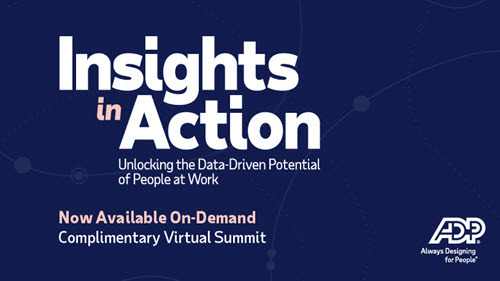Insights in Action: Making AI Your Unbeatable Workforce Advantage
Part of a series | Insights in Action Series

AI is changing the workforce. Discover how to leverage the unbeatable AI advantage in your business through a recent Insights in Action virtual summit session.
Artificial intelligence is changing the workforce. According to a recent OECD survey about AI's impact on the workplace, 80 percent of staff said intelligent tools improved their work performance. More than 64 percent of businesses addressed changing skill needs by retraining or upskilling internal staff, and 70 percent of workers said they were enthusiastic about learning more.
In ADP's recent Insights in Action session "AI's Influence on the Workforce and How to Make It Your Unbeatable Advantage," industry experts Jake Burns, enterprise strategist for Amazon Web Services; Stacia Garr, co-founder and principal analyst at RedThread Research; and Naomi Lariviere, chief product owner at ADP, explored the current state of AI, what comes next and how leaders can implement intelligent tools across their workforce for maximum impact.
The state of intelligent adoption
Put simply, most teams are starting small.
"As I look across the human capital space, I see a huge amount of experimentation in service of efficiency," says Garr. "So focusing on things like search, summarization, prediction, content creation and insight generation. It's very small scale, trying to understand the actual impact on the business if they were to do these things at scale."
Lariviere sees a similar pattern. "A lot of people are still just feeling this technology out and thinking about how they can leverage it. How can I automate processes? How can I use it to help me think differently?" She also highlights a growing desire for more rapid AI adoption but notes that "we see a lot of clients wanting to go fast but then not necessarily having the workers with the skill sets that will enable them to go fast."
Even at a relatively slow speed, however, Burns points to significant strides. "We had a five-person team use Amazon Q code transformation to upgrade over 1,000 production applications from Java 8 to Java 17, and they did it in only two days."
Models are only as good as the data you have. You need to make sure your data is clean, is structured and is ethically managed.
Naomi Lariviere, chief product owner, ADP
Making the most of AI
Connecting the dots is AI's greatest strength. Give intelligent tools access to multiple datasets, define some basic rules and watch the magic happen.
The caveat? Data availability, accuracy and quality all play a role in making the most of AI.
"Models are only as good as the data you have," says Lariviere. "You need to make sure your data is clean, is structured and is ethically managed. You need to start upskilling your employees so that they can better manage and interpret the workforce data that is there, and you need to start fostering cross-functional collaboration to ensure that data isn't being siloed." She notes that in many cases, different teams such as HR, finance, payroll or IT only have small "bits" of the big picture.
Burns, meanwhile, points to the necessary evolution of data strategy. "I've always said this about information security — it's last priority until it becomes first priority. And I'm seeing the same thing right now with data strategy. With AI, your data is your differentiator. You're using the same technology as everyone else. If you feed it better data, you'll get better results." For Burns, building a data lake should be a top priority for organizations looking to leverage AI. By creating a shared space for data from multiple departments, businesses are better prepared to make the most of AI.
Unlocking the AI advantage
So what's the big secret? How do organizations unlock the unbeatable advantage of AI? The optimal equation is simple: AI tools + well-trained talent = success.
Here's why: In isolation, both talent and technology can't keep pace. Despite growing interest in AI, most staff lack the skills to make the best use of intelligent tools. And while AI excels at handling disparate datasets, it lacks the contextual awareness necessary to separate fact from fiction. To unlock the advantage, businesses need both.
For Garr, this raises a critical question: "Is it build or buy AI skills?"
"I think you're going to see a mixture of both," says Lariviere. "We see a lot of undergrads coming in fresh-faced, no experience but they know how to use the technology. But we don't want to leave the rest of the organization behind. Organizations need to create AI literacy programs and get them in front of employees." While Lariviere calls out key skills such as data analytics and digital fluency, she also notes the need for key human capabilities such as creativity, adaptability and emotional intelligence.
For staff interested in leveling up their AI skill sets, Burns notes that "the good news is that there are a lot of free resources out there to prepare. Without spending any money, you can play around with prompts and build applications. There are a lot of employers out there looking to hire people who are eager and willing to learn."
Implemented effectively, AI offers an unbeatable workforce advantage. Register then watch the full Insights in Action session on demand to learn more.




